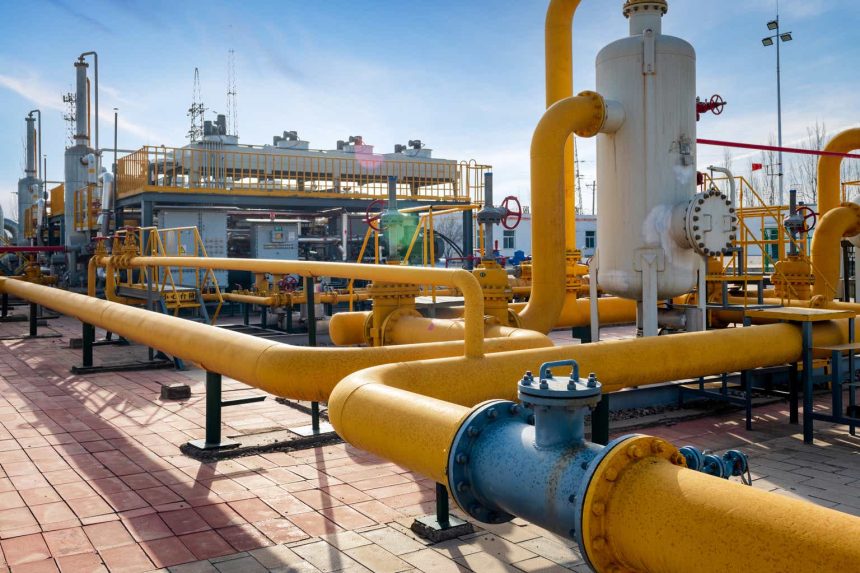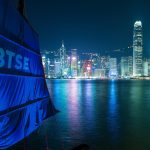Editor’s note: Seeking Alpha is proud to welcome White Star Research as a new contributor. It’s easy to become a Seeking Alpha contributor and earn money for your best investment ideas. Active contributors also get free access to SA Premium. Click here to find out more »
Linde plc (NYSE:LIN) is the largest of the three global leaders in industrial gases at roughly 33% of market share with the other ones being US Air Products and Chemicals (APD) and French Air Liquide (OTCPK:AIQUF). It does business in manufacturing and selling of Industrial and Process gases to distributors and end customers across several sectors, the largest being Chemicals, Manufacturing and Healthcare. With its roots dating back to 19th century Germany, Linde plc emerged in late 2018 through the re-merger of German Linde AG with pre-WW1 US-subsidiary Praxair Inc.
Estimating Linde can continue to grow their defensive world-class core business and leverage it to emerge as the leader in the new wave of green and blue hydrogen, I initiate at Buy with a Price Target of $424 and an estimated upside of 9%.
Key Investment Points
Leadership in a growing defensive Industry with highly resilient Margins and favorable geographic Footprint
Despite the chemicals industry in general being regarded as cyclical, Linde has been able to continuously grow margins and only suffer minimal drawbacks, even during events such as the 2022 European gas crisis (Q2 22 drop was due to a one-off event). While this can also be attributed to the industry’s operating model of almost exclusively engaging in fixed-price long term contracts with full input cost pass-through, compared to its competition, Linde fared extremely well through the cycle, highlighting its best-in-class pricing power.
QoQ Change in Operating Margins (Calculated by Author using Data from Linde’s Financial Results)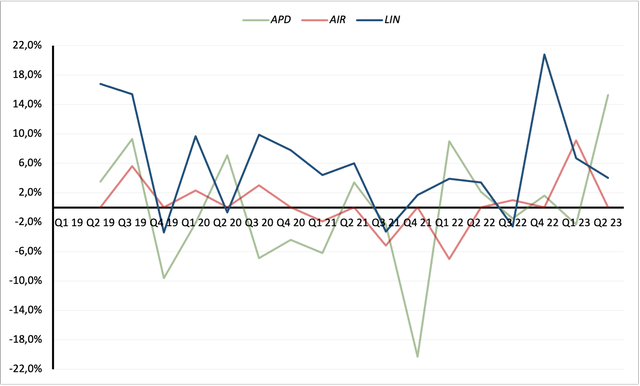
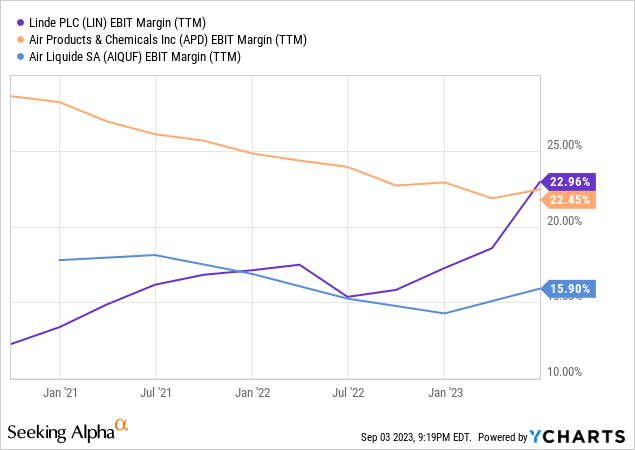
This pricing power is extremely important to note due to sales growth by higher price flowing 100% into gross profit which is not the case for volume or mix associated growth. Despite its defensive nature, the industry is still projected to grow at a roughly 4.5% CAGR until 2030, with APAC experiencing the strongest growth. I see Linde in an excellent position to continue leveraging their already established strength in the APAC region at 18% FY22 market share (APD 9%, AIR 15%) to capitalize on the rising Industrial Gases demand in rapidly growing economies such as India, especially given the lack of local competition able to keep up with Linde’s scale and scope.
Praxair Merger created the Industry’s only truly global Player with Best-in-Class Margin Profile and Profitability
Compared to its main competitors, by combining its legacy EMEA and APAC strength with Praxair’s US business, Linde currently has a significant share of sales coming from all major parts of the world, giving it more operating flexibility and higher resilience against regional changes in economic conditions. After significant initial downward pressure, Linde has also been able to successfully extract synergies out of the merger by consolidating operations leading to an increase in Gross Margin by (as of Q2 FY23) 362bps and Operating Margin by 323bps compared to the 5Y premerger-average.
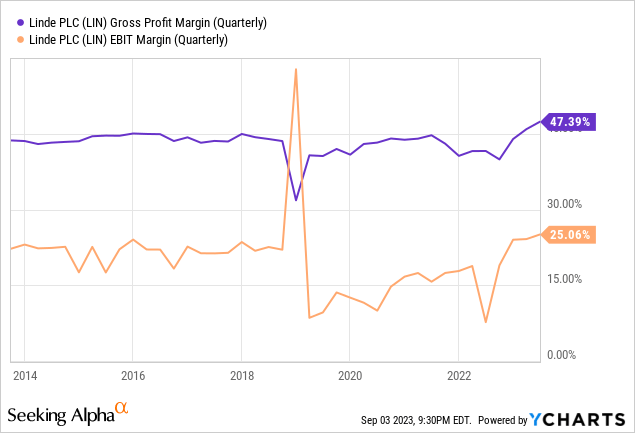
I estimate further upside can be realized here as the operating margin average for legacy EMEA and APAC business still continues to be around 6% below Linde’s ex-Praxair US assets as of Q2 FY23, despite having narrowed from 12% in FY19 right after the merger. Per my calculations, margin convergence to NA levels could add approx. 7% of EBIT or roughly $15 per share at current levels.
Gap in Operating Margin between legacy EMEA and APAC assets and US business is converging (Calculated by Author using Linde’s Financial Results)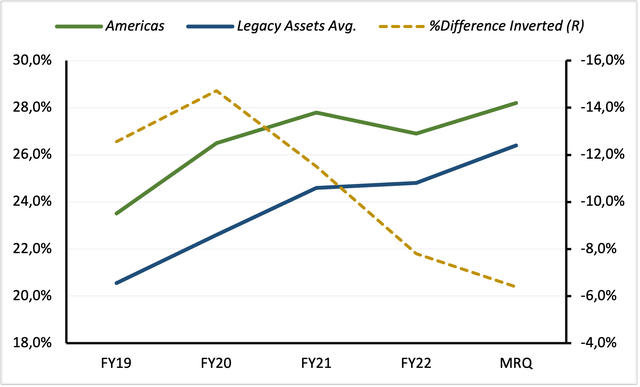
Leverage continued Strength in defensive Core Business to lead Growth in emerging Hydrogen
With strong prospects to grow their core industrial gases business and the relative stability in cash generated from it, Linde is in an excellent position to capitalize on opportunities in clean hydrogen, which is needed for the world’s gradual transition away from fossil fuels. This market is currently highly fragmented with a large amount of small and midsized players, some of them still in startup stage, Linde can leverage its strong capital base to aggressively build its share in the market. The company has reported that it is allocating $7-9 billion to hydrogen investments until 2026, the majority of which clean hydrogen including a $1.8 billion carbon-capture blue hydrogen plant on the US gulf coast, with total planned investment until 2032 exceeding $30 billion. In the US, Linde will also be a major benefactor of the IRA helping the company partially cover this massive upfront CAPEX.
Under-levered Balance Sheet allows for Capital Structure Optimization and Share Buybacks
Linde holds a very strong balance sheet with a net leverage of 1.2x EBITDA. Due to high predictability and resilience of cash flows, I estimate Linde could continue to hold the same A credit rating up until a leverage of 3x, giving it the opportunity to take on up to $20 billion debt at still rather cheap interest rate and use the proceeds to buy back shares or lower its cost of capital as well as engage in promising M&A opportunities. Alongside that the company’s management is constantly signaling their strong commitment to shareholders, having bought back 7% of outstanding stock since Q4 FY20 (see below) and having announced a record $10 billion share buyback program to be completed until July 2024. This could remove another 5% of float at current share price levels. Linde is also a reliable payer of a strong growing dividend, with growth having accelerated since 2020 with 3Y CAGR at 10%. I deem the dividend as highly safe due to, management’s shareholder commitment, a modest current payout ratio of 37% and 30 years of consecutive YoY growth.
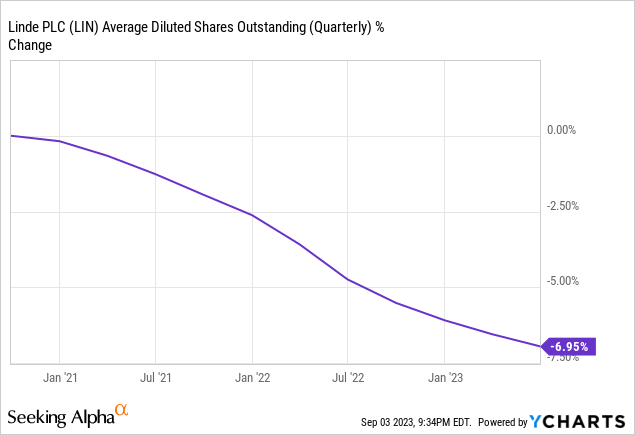
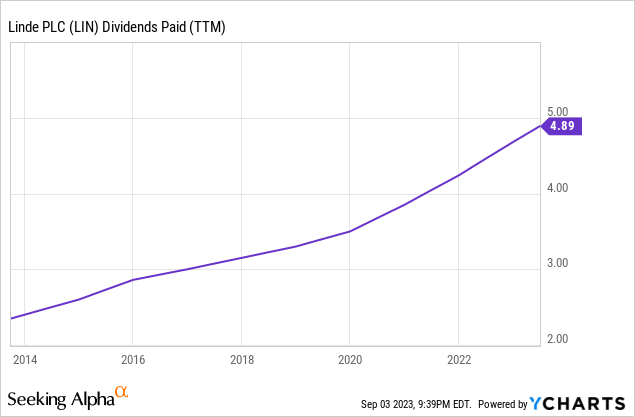
Possible Risks
Overall, I view Linde as an extremely safe pick, given the company’s strong financial and competitive position and its operating model focusing on highly predictable and stable cash inflows. However, there are some risks associated to Linde’s commitments to investments in Hydrogen as well as the company’s rich valuation as of current.
Hydrogen being a potential “much ado about nothing”
As with many fields of science, asking chemists and physicists about the future of hydrogen will yield answers across the entire range of possibilities. Despite the strong market forecasts and the tailwinds due to global energy transition efforts, the technology is still largely unproven, especially concerning its application in the transport sector. Should hydrogen fail to live up to its sky high expectations, this could mean billions of sunk costs for Linde which could have been invested into their core business at high returns. Concerning this however, Linde’s management has clearly communicated that their strategy does not entail speculative investments and particular investments will only proceed if an attractive double digit return can be realized.
Need for greater than expected Hydrogen Investment
Even if hydrogen does prove to be the power source of the future, there are still possible near term headwinds that need to be considered. I estimate some near-and-midterm headwind on margins as new capacity is brought up to utilization. Continued wage and building materials inflation might also lead to actual investment far exceeding planned (as currently happening with APD and their NEOM project), thus lowering FCF and potential shareholder returns through buybacks.
Premium Valuation and high Expectations leave little Room for Error
Being a consensus long with a history of beat-and-raise earnings however, I see some downside risk to the share price, especially if hydrogen investments have a larger than expected impact on free cash flow. Despite being a positive sign for the long-term in my opinion, as significant upfront CAPEX will be needed, the market might react to this negatively, as happened to APD when they announced near term negative FCFs due to high hydrogen-related CAPEX.
Most recent Earnings Snapshot
Before going into the valuation, let’s take a quick look at Linde’s reported Q2 23 results. Revenue for the period came in at $8.2 billion, down 3% compared to Q2 22. Adjusted for last year’s cost-pass-through and FX effects however, underlying sales actually went up by 6%, mainly driven by price increases of 7% offset by volume decline of 6%. Due to these price increases, adj. operating profit also climbed 15% YoY. Following the reveal of these strong results which once again highlight the company’s superb pricing power, full year EPS guidance was raised to $13.80-$14.00. Representing a YoY% EPS growth of 12-14%, the most important point about this is that the higher end of guidance now does not assume an uptrend in economic conditions for the remaining quarters anymore, showing management’s confidence in the company’s ability to maneuver even difficult macro environments.
Valuation
I value Linde with a 5-year DCF assuming a base case FY22-27 sales CAGR of 7.5%, reflecting a mix between core business growth rate and additional upside from hydrogen rollout. In terms of core business, the key growth drivers will be global GDP growth with APAC growing at a higher rate as well as Linde’s discussed pricing power again giving it an edge over competitors and allowing it to grow sales at a faster rates than if just relying on volume growth with 2% from pricing and 4.5% from volume.
For hydrogen I assume a CAGR of 22% given the high momentum for demand in clean H2 leading to a total FY2027 CAGR of 7.5%. I also assume a FY27 operating margin of 26.5% due to continued margin improvement and catchup for APAC and EMEA to NA levels. Capex will increase linearly from 10-14% of revenue with D&A lagging behind 1-year. For net working capital I assume 0% which is the company’s long-term average.
With a WACC of 8% and an estimated infinite growth of 4%, which I find reasonable giving industry forecasts and Linde’s pricing power, I calculate a fair value per share of $415 in the base case. An upside scenario with 9% sales CAGR and a FY op. margin of 28% yields $471 per share and the downside case with growth of 6% and an op. margin of 25% gives $363 respectively. Assigning each scenario a probability (base:55%, bull:30%, bear:15%) I obtain a blended average fair value of $424 per Linde share, representing a roughly 9% upside to current.
Linde DCF Analysis (Company Filings and Authors Projections)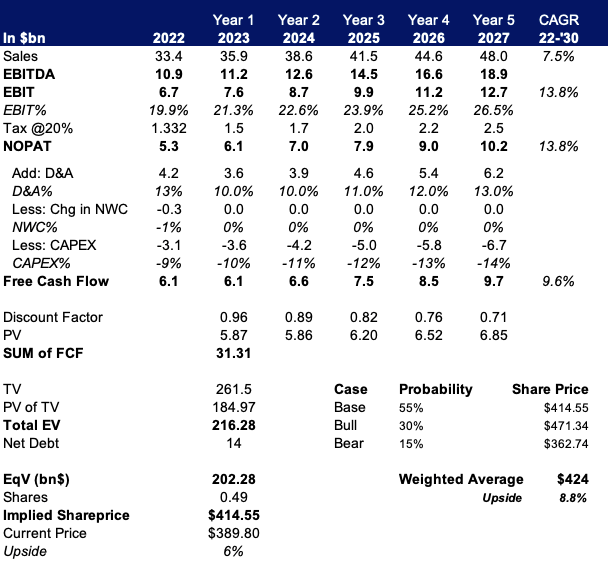
Looking at comps, Linde trades at a roughly 7% (fwd P/E as of 29th Aug) premium compared to peer average, which I see as reasonable given its best-in-class margin profile and profitability metrics while having the lowest leverage.
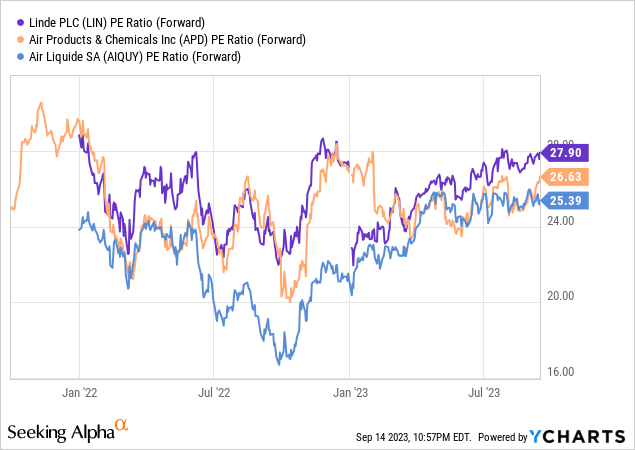
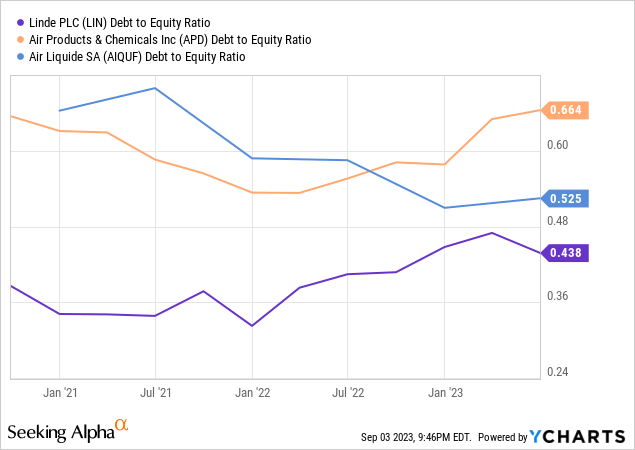
I don’t see any overtly meaningful near term catalysts that could warrant the stock to trade at a higher multiple as it is already holding a premium valuation compared to peers. On the flipside, as described earlier, the current premium valuation could trigger a significant decline in share price if Linde fails to deliver on the market’s high expectations or if margin convergence between legacy Linde and ex-Praxair assets slows down or even reverses or announces higher than expected CAPEX.
What to Watch out for in Q3 Results
Linde will reports its Q3 earnings on 25th October, in my opinion there are 3 key points to watch.
- Margin Development: Specifically concerning the gap between EMEA/APAC and Americas segments and sustainability of current margins
- More Details on Linde’s Hydrogen Roadmap: Incl. Info on targeted Returns for announced Projects
- China Business: How will PBoC stimulus impact Linde’s China operations which have relatively lagged in the recent past?
- Pricing Power: How do sales evolve in terms of pricing? Can the company keep raising prices / keep them at elevated levels or does it have to give back some of the increase?
Editor’s Note: This article discusses one or more securities that do not trade on a major U.S. exchange. Please be aware of the risks associated with these stocks.
Read the full article here


